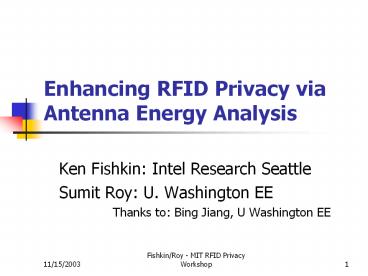Enhancing RFID Privacy via Antenna Energy Analysis - PowerPoint PPT Presentation
Title:
Enhancing RFID Privacy via Antenna Energy Analysis
Description:
Enhancing RFID Privacy via Antenna Energy Analysis Ken Fishkin: Intel Research Seattle Sumit Roy: U. Washington EE Thanks to: Bing Jiang, U Washington EE ... – PowerPoint PPT presentation
Number of Views:110
Avg rating:3.0/5.0
Title: Enhancing RFID Privacy via Antenna Energy Analysis
1
Enhancing RFID Privacy via Antenna Energy Analysis
- Ken Fishkin Intel Research Seattle
- Sumit Roy U. Washington EE
- Thanks to Bing Jiang, U Washington EE
2
Introduction
- With great power, comes great responsibility
- Privacy worries have a legitimate basis
- Deployed naïvely, embedding of RFID tags in
consumer items presents a serious danger to
privacy. (Ari Juels) - Can we address privacy worries realistically?
- Can we provide post-checkout value?
3
Isnt this a known problem?
- Much investigation of privacy and security
mechanisms in other domains - File systems, Email, Ecommerce, Wireless
- We can leverage some of this
- One qualitative difference the donation of
energy by one party to the other. - Bad news cant do much computation
- Is there good news? Can we leverage this unique
difference? - Two proposals will be presented
4
Distance implies distrust
- Why arent people upset about bar codes?
- Bar code scanners are close and known
- Most nightmare RFID scenarios involve distant
and unknown - Basic idea can we require higher bona fides
for more distant interrogators?
5
First idea distance inference
- Does the energy wave change with distance?
- If so, can we infer distance from wave
properties? - Can we do it robustly?
- RFID signal highly influenced by environment
- Three techniques presented
- 1 largely negative result
- 1 open for investigation
- 1 initially positive result
6
1 Look at wave curvature
7
1 Look at wave curvature
- Fraunhofer far field effect (2 f d2) / c
0.3 0.05
13.56 0.01 m 0.00 m
900 0.54 m 0.01 m
2450 1.46m 0.41m
d
f
(Environmental fluctuation may swamp comparison)
8
2 Look at wave phase
- Need to compare amongst multiple tags.
- Under investigation
9
3 Look at noise
- Signal/noise goes down with propagation
- Doesnt require multiple tags
10
Spoofing
- Cant the hostile reader just change its energy
signature to match that of a nearby reader? - NO you cant have less than zero noise. You can
spoof being farther (but why would you?) but not
nearer than you really are.
11
Assuming it works
- Slight enhancement to tag circuitry enforce
maximum range, and/or report reads beyond that
range - And/or turn yourself into a blocker tag
- Requires no reader modification
- Requires no protocol modification
- But limited distant interrogators may be OK,
nearby may not be
12
Second idea tiered revelation
- Can we go Beyond the kill switch?
- The problem with radio frequency ID is that its
clear how retailers and manufacturers might
benefit from attaching smart tags to their
products, but its utterly unclear how this helps
consumers. (Technology review, 3 Nov 2003) - Look at scenarios which provide post-purchase
direct benefit to consumers
13
Energy-sensitive revelation
- Bought at Nordstroms, downtown Seattle
- Bought 7/28/03
- Made in Kuala Lumpur, Factory 17
- Made 2/5/03
- Benetton model X3J4
- Size L
- 75 cotton, 25 poly
- Mauve
- Shirt
- Object
Nordstroms
Recall check
- They dont all require all the same information
- What if we make the Bar higher, the more
information you want?
Insurance
Dryer
Washer
14
The proposal
- Tags move to a challenge-response system.
- Use energy
- the closer the reader is, the more processing you
can do - Tag then reveals highest level of authenticated
information
15
How this works
- Reader specifies which level it wants
- Tag specifies level of security, and/or amount of
energy needed - Reader proceeds at that level of security
- Respond if and only if get energy and security
required - Only energy increases rough and simple distance
requirement - Only security increases as existing protocols
- Both increase interesting combination to explore
16
Assuming it works
- Requires changes to readers
- Requires changes to tags
- Requires changes to protocol
- But buys you a much more robust, extensible
functionality
17
Conclusion
- Distance implies distrust closeness implies
comfort - Energy can be used as a variable in the privacy
equation - Two examples presented one easy and weaker, one
hard and stronger































